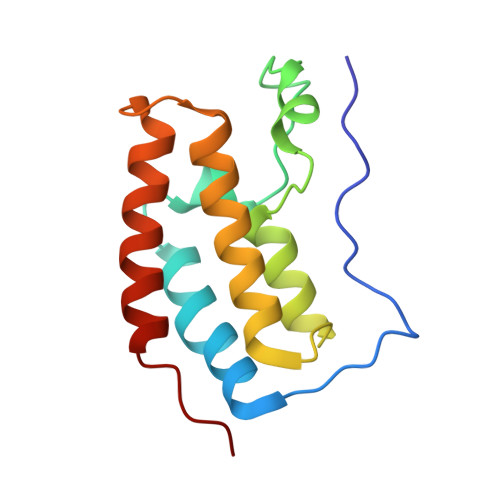BET bromodomain ligands: Probing the WPF shelf to improve BRD4 bromodomain affinity and metabolic stability.
Jennings, L.E., Schiedel, M., Hewings, D.S., Picaud, S., Laurin, C.M.C., Bruno, P.A., Bluck, J.P., Scorah, A.R., See, L., Reynolds, J.K., Moroglu, M., Mistry, I.N., Hicks, A., Guzanov, P., Clayton, J., Evans, C.N.G., Stazi, G., Biggin, P.C., Mapp, A.K., Hammond, E.M., Humphreys, P.G., Filippakopoulos, P., Conway, S.J.(2018) Bioorg Med Chem 26: 2937-2957
- PubMed: 29776834
- DOI: https://doi.org/10.1016/j.bmc.2018.05.003
- Primary Citation of Related Structures:
6FSY, 6FT3, 6FT4 - PubMed Abstract:
Ligands for the bromodomain and extra-terminal domain (BET) family of bromodomains have shown promise as useful therapeutic agents for treating a range of cancers and inflammation. Here we report that our previously developed 3,5-dimethylisoxazole-based BET bromodomain ligand (OXFBD02) inhibits interactions of BRD4(1) with the RelA subunit of NF-κB, in addition to histone H4. This ligand shows a promising profile in a screen of the NCI-60 panel but was rapidly metabolised (t ½ = 39.8 min). Structure-guided optimisation of compound properties led to the development of the 3-pyridyl-derived OXFBD04. Molecular dynamics simulations assisted our understanding of the role played by an internal hydrogen bond in altering the affinity of this series of molecules for BRD4(1). OXFBD04 shows improved BRD4(1) affinity (IC 50 = 166 nM), optimised physicochemical properties (LE = 0.43; LLE = 5.74; SFI = 5.96), and greater metabolic stability (t ½ = 388 min).
Organizational Affiliation:
Department of Chemistry, Chemistry Research Laboratory, University of Oxford, Mansfield Road, Oxford OX1 3TA, United Kingdom.
















